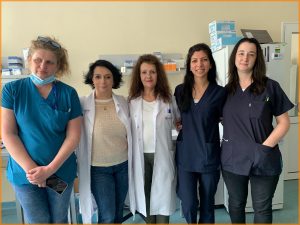The following interview is part of our interview series that we are conducting with Key Opinion Leaders, Experts and Business Managers within the HLA field. In this interview, Prof. Milena Ivanova MD, Molecular Biologist from the University Hospital Aleksandrovska talks about their experiences and thoughts on HLA laboratory activities. We hope this series will shed light on trends and challenges within the profession and will be helpful to all HLA experts.

Prof. Milena Ivanova, MD , Molecular Biologist, Lab director
What is your role in the lab?
I am a lab co-director and lab supervisor of the Histocompatibility and Immunogenetics laboratory at the department Clinic of Immunology at the University Hospital Alexandrovska in Sofia, Bulgaria. Me and my team started a collaboration with Omixon back in 2016 when we implemented the Holotype HLA kit as our routine typing technique of clinical and registry samples later in 2017. I am also very active in the research field focusing on the role of HLA in the immune editing in hematological malignancies and MICA research of certain types of oncological diseases.
What is the biggest challenge your laboratory is currently facing?
Apparently, the corona virus pandemic – I’m sorry to say that as a first response, but we hear about the corona virus situation everywhere which is currently complicating our lives both in the professional and private sides.
But back to the question, our laboratory is currently transitioning from a medium throughput laboratory to a high throughput laboratory, which is opening new questions and challenges while we need to keep our routine lab services running smoothly for both HSCT and SOT activities.
Are you considering implementing automation in your lab in the near future, if so, which liquid handler would you like to use in routine and why?
Implementation of automation is one of our planned projects, so yes, we are considering that option. Our goal is to get a liquid handler that will be used for several applications, including NGS. This means that it has to be a very flexible device to cover different aspects of different laboratory DNA methods. At the moment, we are still in the process of collecting the necessary information to select the most suitable platform for our needs.
What aspects of Holotype HLA would benefit most from automation?
When it comes to NGS, we want to ideally implement both pre- and post PCR steps of the workflow. Although the Holotype HLA protocol is very easy to do manually, we are planning to automate the library preparation part in order to improve the level of standardization of the quality of the library. The library preparation steps are the part of the protocol with the higher amount of lab technician hands-on-time, so if we can automate this process, we can utilize the saved time in a more efficient manner and eliminate possible human variability in the process.
What do you think are the disadvantages of automation?
In my opinion, the biggest disadvantage is the initial investment. Else, we have to be very careful to detect possible contamination, especially in closed systems like liquid handlers. So, we have to set up the proper procedures to control all high risk steps that are performed on the robot.
What benefits should a new NGS technology bring to the lab in order to be appealing?
The benefit of a new NGS technology for us should be an increase of the sample throughput. Furthermore, the advantage of it should be shortening the lab techs’ hands-on-time, and decreasing the total analysis time. Another benefit we expect from a new technology should be the increase of the resolution and to allow incorporation of additional loci with potential clinical significance. For instance, when we started using NGS, the methodology brought DPB1 typing into our routine testing and now we are able to match patient-donor pairs more accurately. Thus, in the future, we would like to also focus on MICA typing as well as non-classical HLA genes.

The team of Prof. Ivanova
What is the biggest hurdle to overcome when implementing a new technology, such as NGS?
Well, the biggest hurdle is the fact that we need to adjust our e
ntire established, routine workflow, train the staff and find proper lab equipment. And all that while having in mind that it has to be according to the EFI/ISO/ASHI standards.
Which one do you prefer to use: singleplex or multiplex HLA genotyping by NGS?
We can split this question into two parts. I would say that the multiplex approach would be very suitable for routine typing because of its simplicity and speed like for example OmniType protocol. With around 6 hours to complete the library preparation starting from gDNA until loading the sequencer, it is easily doable. But PCR must be well balanced to avoid allele dropouts! For research purposes, I think that the singleplex approach is much better, because there is much lower risk of a potential allele dropout.
What will the HLA lab look like in 10 years?
My opinion is that in 10 years we’ll all have very simple NGS protocols, much more affordable and HLA typing will not be applicable only for transplant programs, but also for personalized immunotherapy, for instance in oncology.
What are your major expectations from an NGS service provider?
If I would use an NGS provider for HLA typing I am expecting them to deliver a very high throughput of the samples at a very low cost for me. I can imagine using an NGS service provider for applications that are not addressed by the lab or that it is not feasible to be performed in our lab, such as WES or WGS.
We would like to say thank you to Prof. Ivanova for answering our questions!
Are you interested in more interviews with the HLA community?
You can find previous interviews here:






